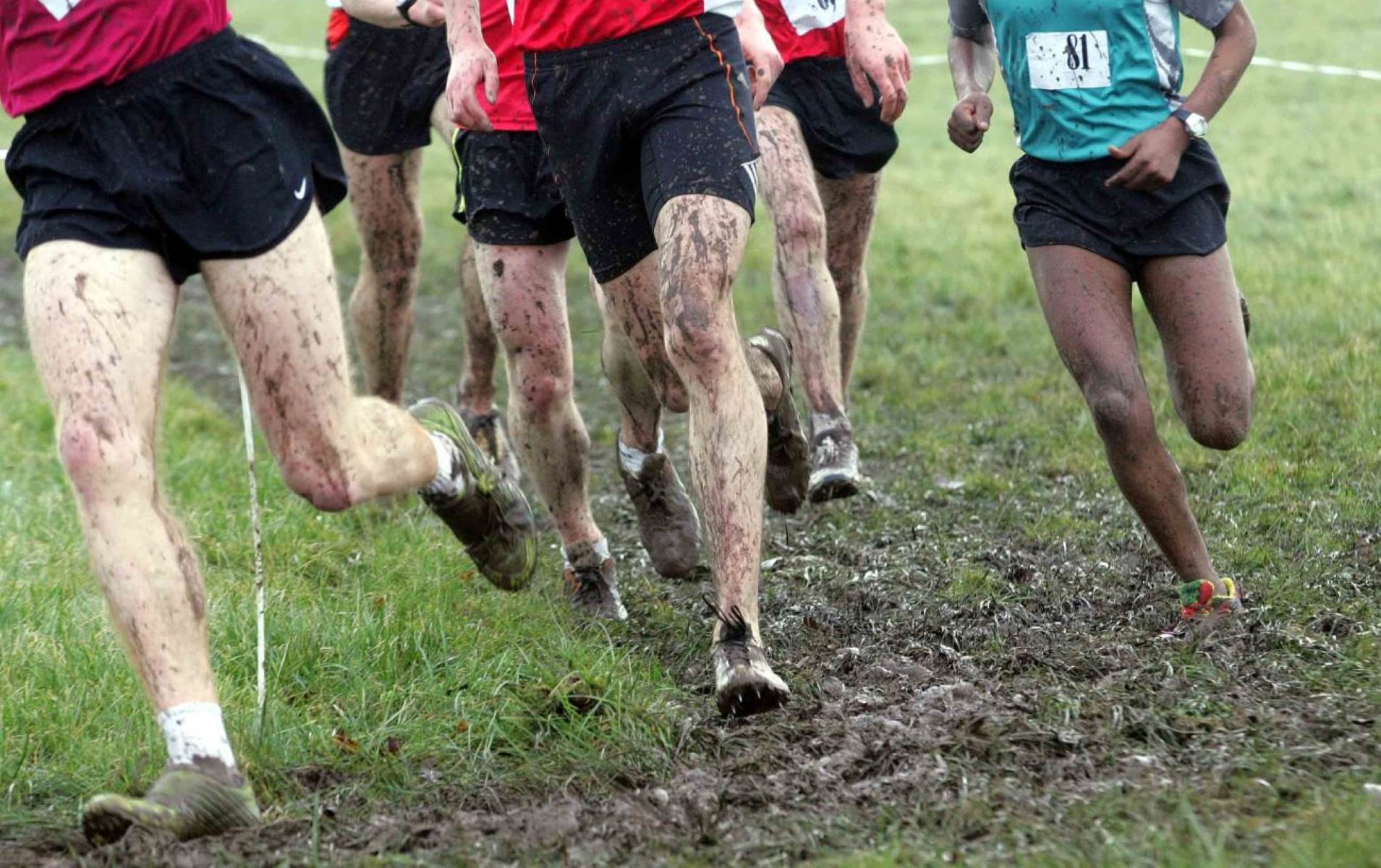

Featured
How Can I Run Faster In Cross Country
Modified: January 22, 2024
Discover the expert tips and training techniques to improve your speed in cross country. Get featured strategies to run faster and dominate your next race.
Introduction
Welcome to the world of cross country running, where the thrill of the race meets the challenges of endurance and speed. Whether you are a seasoned runner or just starting out, one thing is clear – everyone wants to run faster. In the sport of cross country, speed is not only desirable, but essential for success. The ability to maintain a swift pace over varied terrain can be the difference between a mediocre finish and crossing the finish line triumphant.
Why is speed so important in cross country? Well, it all comes down to competition. In a race where distance and time are the ultimate benchmarks, faster runners have a clear advantage. The ability to maintain a swift pace allows you to surge ahead of your competitors, gain strategic advantage, and ultimately finish with a better time.
Now, you may be wondering, how can I become faster in cross country? The answer lies in a combination of factors, including building endurance, working on running form, incorporating speed workouts, and implementing proper nutrition and hydration strategies. In this article, we will delve into the various aspects of becoming a faster cross country runner and provide you with actionable tips to enhance your performance.
So, lace up your running shoes and get ready to embark on a journey of speed and endurance. With the right training and mindset, you can improve your times and conquer new personal records in cross country running.
Importance of speed in cross country
Speed is a crucial aspect of cross country running that can make or break your performance. It is not just about being the fastest runner on the team, but about having the ability to maintain a swift pace throughout the entire race. Here are some reasons why speed is essential in cross country:
- Competitive Advantage: In a race where every second counts, being able to run faster gives you a significant advantage over your competitors. It allows you to break away from the pack, gain an edge, and secure a better position in the race.
- Time Efficiency: Since cross country races are typically held on natural terrains with varying elevations and obstacles, maintaining a faster pace allows you to cover the distance in a shorter amount of time. This is crucial for achieving a personal best or meeting time goals.
- Strategic Positioning: Speed enables you to strategically position yourself during different parts of the race. Whether it’s accelerating to pass other runners or surging ahead on uphill sections, being faster gives you the flexibility to make strategic moves that can impact your overall performance.
- Mental Endurance: Running at a faster pace demands mental discipline and resilience. By training and improving your speed, you develop mental toughness and the ability to push through fatigue, enabling you to finish strong even when your body is tired.
- Overall Performance Improvement: Working on speed not only enhances your performance in cross country races but also positively impacts other areas of running. It improves your efficiency, stride length, and overall running economy, making you a more efficient and faster runner in any distance.
It’s important to note that speed should not be the sole focus in cross country running. Endurance and pacing are equally important elements to consider. However, by prioritizing speed and incorporating specific training techniques, you can elevate your performance and achieve new personal records on the cross country course.
Building endurance for faster running
In cross country running, endurance is a key factor for sustained speed and performance. The ability to maintain a steady pace over long distances is essential for achieving faster running times. Here are some strategies to help you build endurance:
- Long Runs: Incorporate long runs into your training schedule to gradually increase your mileage and build up endurance. Start with a comfortable distance and gradually increase the duration each week. Focus on maintaining a steady pace, rather than speed, during these runs.
- Hill Training: Include hill workouts in your training routine to improve both strength and endurance. Running uphill strengthens your leg muscles and cardiovascular system, while running downhill helps improve your running economy and agility.
- Interval Training: Integrate interval training into your workouts to boost your endurance and speed. Alternate between high-intensity intervals of faster running and recovery periods of slower running or walking. This type of training helps improve your cardiovascular capacity and trains your body to sustain a faster pace.
- Cross-Training: Engage in other forms of cardiovascular exercise, such as cycling or swimming, to supplement your running training. Cross-training helps improve overall endurance and reduces the risk of overuse injuries.
- Gradual Progression: Avoid the temptation to increase your mileage or intensity too quickly, as it can lead to burnout or injury. Gradually increase your training load to allow your body to adapt and recover properly.
- Rest and Recovery: Adequate rest and recovery are crucial for building endurance. Make sure to schedule rest days in your training plan and prioritize quality sleep to allow your body to repair and rebuild muscle tissue.
Remember, building endurance takes time and consistency. Be patient with your progress and listen to your body to prevent overexertion or injury. By gradually increasing your training load and incorporating these strategies into your routine, you’ll develop the endurance needed for faster and more successful cross country running.
Incorporating speed workouts into training
If you want to become faster in cross country running, incorporating speed workouts into your training regimen is essential. These workouts specifically target your speed and help improve your overall running performance. Here are some effective ways to incorporate speed workouts into your training:
- Interval Training: Intervals consist of alternating periods of high-intensity running with periods of active recovery. For example, you can sprint for 200 meters and then jog or walk for 200 meters. Repeat this cycle for a designated number of repetitions. Interval training improves your anaerobic fitness and teaches your body to sustain a faster pace.
- Tempo Runs: Tempo runs involve sustained efforts at a comfortably hard pace, just below your maximum effort. These runs should be challenging, but you should still be able to maintain a conversation. Start with shorter tempo runs and gradually increase the duration. Tempo runs improve your lactate threshold, allowing you to run faster for longer periods.
- Fartlek Runs: Fartlek, which means “speed play” in Swedish, involves unstructured bursts of faster running within a longer run. During a run, randomly pick an object (e.g., a tree, signpost) and sprint to it, then recover at an easy pace until you feel ready to pick another object. Fartlek runs help improve your speed, endurance, and mental toughness.
- Track Workouts: Running workouts on a track can be highly beneficial for speed improvement. For example, you can do repeat 400-meter sprints at a fast pace, with recovery periods in between. Track workouts help you gauge your progress and give you the opportunity to focus on correct pacing and form.
- Hill Repeats: Find a hilly route or incline and do hill repeats. Run uphill at a hard effort for a specific distance (e.g., 200 meters), then recover by jogging or walking back down. Repeat this cycle for a designated number of times. Hill repeats build strength and power, translating into increased running speed on flat terrain.
When incorporating speed workouts, it’s crucial to listen to your body and gradually increase the intensity and volume of each workout. Allow sufficient recovery time between workouts to prevent overtraining and reduce the risk of injuries. Consult with a coach or experienced runner to help structure your speed workouts effectively and make them suitable for your current fitness level and goals.
By incorporating speed workouts into your training routine, you will challenge your body to run at a faster pace, improve your anaerobic capacity, and enhance your overall speed and performance in cross country running.
Proper running form for faster times
Having proper running form is crucial for maximizing your speed and efficiency in cross country running. It allows you to move more fluidly, optimize your energy expenditure, and reduce the risk of injuries. Here are some key elements of proper running form that can help you achieve faster times:
- Posture: Maintain an upright posture with a slight forward lean. Avoid slouching or hunching over, as it can restrict your breathing and hinder your forward momentum.
- Head and Eyes: Keep your head up and eyes focused about 20 to 30 feet ahead. Avoid looking down at your feet, as it can disrupt your balance and affect your stride.
- Arms and Shoulders: Keep your arms relaxed and bent at a 90-degree angle. Swing them forward and backward in a coordinated motion with your leg movements. Avoid crossing your arms in front of your body, as it can cause unnecessary rotation and energy loss.
- Hands and Fingers: Form a loose and relaxed fist with your hands. Avoid clenching your fists too tightly, as it can lead to unnecessary tension in your upper body.
- Hips and Pelvis: Engage your core muscles and maintain a neutral pelvis position. Avoid excessive pelvic tilting or rotating, as it can lead to inefficient movement and instability.
- Legs and Stride: Aim for a quick and efficient stride, with your feet landing directly under your body. Avoid overstriding, which means reaching your foot too far in front of your body, as it can result in braking forces and decreased speed.
- Cadence: Focus on increasing your cadence, which refers to the number of steps you take per minute. A higher cadence can help improve your speed and reduce the risk of overstriding. Aim for a cadence of around 180 steps per minute.
- Breathing: Practice diaphragmatic breathing to maximize oxygen intake. Breathe deeply and rhythmically, coordinating your breath with your stride pattern. Avoid shallow chest breathing, which can lead to fatigue and inefficient oxygen exchange.
It’s important to note that proper running form may vary slightly from person to person, depending on individual biomechanics and body characteristics. Experiment with different cues and techniques to find what works best for you. Consider working with a running coach or analyzing your form through video analysis to identify areas for improvement.
By focusing on and maintaining proper running form, you can optimize your energy utilization, reduce unnecessary movement, and ultimately run faster, longer, and with better efficiency in cross country races.
Strategies for improving stride length and cadence
In cross country running, the length of your stride and the speed at which you take each step, known as cadence, play a crucial role in determining your overall running speed. By focusing on improving both stride length and cadence, you can enhance your efficiency, increase your running speed, and ultimately improve your performance. Here are some strategies to help you do just that:
- Proper Warm-up: Before a training session or race, warm up properly to prepare your muscles and joints. Incorporate dynamic stretches and drills that specifically target your leg muscles, such as high knees, skipping, and strides. This will help improve joint mobility and prepare your body for optimal stride length and cadence.
- Strength and Flexibility Exercises: Work on strengthening your leg muscles, including quadriceps, hamstrings, and glutes, through exercises such as lunges, squats, and leg presses. Additionally, focus on improving flexibility through stretches targeting your hip flexors, hamstrings, and calves. Increased strength and flexibility contribute to a more powerful and efficient stride.
- Hill Training: Incorporating hill workouts into your training routine can improve both stride length and cadence. As you run uphill, your stride naturally extends, helping to increase your stride length. Additionally, the resistance provided by the incline requires a faster cadence to maintain momentum. This combination strengthens your leg muscles and trains your body to adapt to varied terrain.
- Interval Training: Interval training is not only beneficial for overall speed but also for improving stride length and cadence. By incorporating shorter, faster intervals into your workouts, you challenge your body to increase your stride length while maintaining a faster cadence.
- Technique Drills: Engage in technique-focused drills to reinforce proper running mechanics. Examples include high knees, butt kicks, and A-skips. These drills help improve muscle coordination, stride length, and cadence.
- Focus on Quick Turnover: To increase your cadence, focus on quickening your leg turnover rate. This can be achieved by using a metronome or music with a specific beat to match your desired cadence. Gradually increase your cadence over time, aiming for around 180 steps per minute.
- Pacing and Rhythm: Practice maintaining a consistent and steady pace during your runs. Focus on finding a rhythm that allows you to sustain a desired stride length and cadence. This will help you develop muscle memory and make it easier to replicate during races.
It’s important to remember that improving stride length and cadence takes time and practice. Start by gradually implementing these strategies into your training routine and be patient with your progress. Regular feedback from a coach or experienced runner can also be valuable in identifying areas for improvement and providing guidance on technique.
By focusing on and improving stride length and cadence, you will maximize your running efficiency, enhance your speed, and ultimately improve your overall performance in cross country running.
Utilizing interval training for increased speed
Interval training is a powerful tool in increasing speed and improving overall performance in cross country running. By incorporating short, intense bursts of high-speed effort followed by controlled recovery periods, interval training pushes your aerobic and anaerobic capacities, leading to significant improvements in speed and endurance. Here are some strategies for utilizing interval training effectively:
- Varying Distance and Intensity: Mix up the distance and intensity of your interval workouts to target different energy systems and stimulate muscle adaptation. For example, you can alternate between shorter, faster intervals like 400-meter sprints and longer, slightly slower intervals like 800 or 1,000 meters. This variation challenges your body and helps improve both sprinting speed and sustained endurance.
- Structured Workout Plan: Have a well-designed workout plan that includes specific intervals and recovery periods. For instance, perform 4 to 6 repetitions of 400 meters at a fast pace with 1-2 minutes of rest in between. Gradually increase the number of repetitions or the intensity of the intervals over time as your fitness level improves.
- Progressive Overload: Apply the principle of progressive overload to interval training. Start with a modest intensity and gradually increase the intensity or duration of the intervals as your body adapts. This gradual progression challenges your muscles and cardiovascular system, leading to continuous improvement in speed and performance.
- Active and Passive Recovery: During the recovery period between intervals, you can choose between active recovery (light jogging or walking) and passive recovery (complete rest). Active recovery helps flush out metabolic waste and speed up recovery, while passive recovery allows for a more complete rest. Experiment with both approaches and find what works best for you.
- Track or Timed Intervals: Use a track to precisely measure and time your intervals, ensuring accuracy and consistency in your training. Alternatively, you can use a stopwatch or timer to track your intervals during outdoor runs. Being able to measure your progress helps you set goals and monitor improvements over time.
- Mental Focus and Endurance: Interval training pushes you to your limits and requires mental toughness. Practice maintaining focus and staying committed to the intensity of each interval, helping you build mental endurance that translates to improved race performance.
- Periodization and Recovery: Incorporate periodization into your training plan by alternating intense interval workouts with periods of active recovery or lower-intensity training. This approach allows for sufficient recovery and adaptation, reducing the risk of overtraining and injuries.
Remember, interval training should be tailored to your fitness level and goals. Consult with a coach or experienced runner to design an interval training plan that is suitable for your specific needs. By implementing interval training properly and progressively, you can experience significant gains in speed, endurance, and overall performance in cross country running.
Strength training exercises to enhance running performance
Strength training is a valuable component of any cross country runner’s training program. Incorporating specific exercises to target key muscle groups can improve running performance, prevent injuries, and enhance overall strength and power. Here are some strength training exercises that can benefit your running performance:
- Squats: Squats are a compound exercise that targets multiple muscle groups, including your quadriceps, hamstrings, glutes, and core. They help improve lower body strength and power, essential for generating propulsion and maintaining a strong running form. Incorporate variations like goblet squats or single-leg squats for added challenge.
- Lunges: Lunges target your quadriceps, hamstrings, glutes, and calves, while also engaging your core for stability. They mimic the movement patterns during running and help improve leg strength and balance. Experiment with forward lunges, reverse lunges, and side lunges to work different muscles and challenge your coordination.
- Deadlifts: Deadlifts primarily target your posterior chain, including your glutes, hamstrings, and lower back. Strong posterior chain muscles are essential for maintaining proper running posture and generating power when pushing off the ground. Start with lighter weights and focus on maintaining proper form throughout the movement.
- Calf Raises: Calf raises help strengthen your calf muscles, which play a significant role in providing push-off power during running. Perform calf raises on a step or using a calf raise machine to target both the gastrocnemius and soleus muscles in your calves.
- Planks: Core strength is crucial for maintaining stability and efficient movement while running. Planks engage your entire core, including your abdominal muscles, obliques, and lower back. Aim to hold a plank position for at least 30 seconds to start and gradually increase the duration as your core strength improves.
- Bridges: Bridges target your glutes, hamstrings, and lower back muscles, which are important for hip stability and generating power during running. Lie on your back with knees bent and lift your hips off the ground, squeezing your glutes at the top. This exercise improves hip strength, stability, and overall running performance.
- Resistance Band Exercises: Incorporate exercises using resistance bands to target specific muscle groups such as hip abductors, adductors, and hip flexors. These exercises help improve hip stability, balance, and overall strength, which are crucial for maintaining proper running form.
- Plyometric Exercises: Plyometric exercises, such as box jumps and jump squats, help improve explosive power, agility, and speed. These exercises engage fast-twitch muscle fibers and mimic the explosive movements required during running. Start with lower heights and progress gradually to reduce the risk of injury.
When incorporating strength training into your routine, aim for two to three sessions per week, focusing on a variety of exercises targeting different muscle groups. Start with lighter weights or bodyweight exercises and gradually increase the intensity as your strength improves. Remember to prioritize proper form and range of motion to maximize the benefits and reduce the risk of injuries.
By including these strength training exercises in your cross country training program, you can enhance running performance, improve power and stability, and reduce the risk of common running-related injuries.
Nutrition and hydration tips for optimal speed
Proper nutrition and hydration are essential for fueling your body and maximizing your speed and performance in cross country running. The foods and fluids you consume before, during, and after your runs can significantly impact your energy levels, endurance, and overall running speed. Here are some tips for optimal nutrition and hydration:
- Pre-Run Fuel: Aim to consume a balanced meal or snack containing carbohydrates, protein, and healthy fats before your run. Carbohydrates provide readily available energy, while protein aids in muscle repair and recovery. Include foods like whole grains, fruits, lean proteins, and nuts in your pre-run meals or snacks.
- Hydration: Stay hydrated throughout the day by drinking water regularly, not just before your run. Dehydration can negatively affect your performance and speed. Drink an adequate amount of water, and consider electrolyte-enhanced beverages for longer runs or when running in hot and humid conditions.
- During-Run Fuel: For longer runs or races, consider consuming easily digestible carbohydrates, such as sports drinks, gels, or energy chews, to replenish glycogen stores and sustain your energy levels. Experiment with different fueling options during training to find what works best for you.
- Post-Run Recovery: After your run, prioritize post-run recovery nutrition. Consume a combination of carbohydrates and protein within 30-60 minutes after your run to replenish glycogen stores and promote muscle repair. Examples include a protein shake, chocolate milk, or a balanced meal with lean protein, complex carbohydrates, and vegetables.
- Balanced Diet: Maintain a well-balanced diet that includes a variety of nutrient-dense foods to support overall health and performance. Focus on incorporating fruits, vegetables, whole grains, lean proteins, and healthy fats into your meals and snacks. These foods provide essential vitamins, minerals, and antioxidants that help support optimal speed and performance.
- Timing of Meals: Plan your meals and snacks strategically to allow for proper digestion before your runs. Allow at least 2-3 hours for a larger meal and 1-2 hours for a smaller snack before running. This will help prevent discomfort and ensure that your body has sufficient energy stores to sustain speed and endurance.
- Individual Experimentation: Every runner is unique, and what works for one person may not work for another. It’s essential to experiment with different nutrition and hydration strategies during training runs to find what best suits your body and needs. Pay attention to how different foods and fluids make you feel and perform during your runs.
- Consultation: If you have specific dietary concerns or questions, consider consulting with a sports nutritionist or registered dietitian who can provide personalized guidance based on your individual needs and goals.
Remember, nutrition and hydration should be an integral part of your training plan. By fueling your body with the right foods and fluids, you can optimize your energy levels, enhance your speed, and improve your overall performance in cross country running.
Avoiding common pitfalls and injuries in cross country running
Cross country running is a demanding sport that can push your limits and test your endurance. To ensure a successful and injury-free season, it’s important to be aware of common pitfalls and take proactive measures to prevent injuries. Here are some tips to help you avoid common pitfalls and injuries in cross country running:
- Gradual Progression: Avoid the temptation to increase mileage, intensity, or training volume too quickly. Gradually build up your training load over time to allow your body to adapt and recover properly. Sudden increases in distance or intensity can lead to overuse injuries and burnout.
- Proper Warm-up and Cool-down: Always start your runs with a proper warm-up. Engage in dynamic stretches and drills to prepare your muscles and joints for the demands of running. Similarly, don’t forget to cool down after each run to help your body recover and prevent muscle stiffness and soreness.
- Listen to Your Body: Pay attention to any pain, discomfort, or signs of fatigue during or after your runs. It’s important to differentiate between normal muscle soreness and potential injuries. If something doesn’t feel right, take the necessary rest or seek professional medical advice to avoid exacerbating an injury.
- Wear Appropriate Shoes: Invest in a good pair of running shoes that provide proper support, cushioning, and stability. Replace your shoes regularly when they show signs of wear and tear. Ill-fitting or worn-out shoes can lead to foot, ankle, and knee injuries.
- Train on Varied Terrain: Cross country courses often involve different types of terrain, including grass, trails, and hills. Incorporate training on varied terrain to prepare your body for the specific demands of the race. This will help improve your stability, agility, and overall performance on race day.
- Strength and Conditioning: Include regular strength training exercises to strengthen your muscles and prevent imbalances that may lead to injury. Focus on exercises targeting your core, hips, glutes, and leg muscles to improve strength, stability, and resilience.
- Rest and Recovery: Prioritize rest and recovery as an integral part of your training. Adequate rest allows your body to heal, adapt, and become stronger. Include rest days in your training schedule and consider incorporating active recovery activities such as gentle stretching, foam rolling, or low-impact cross-training exercises.
- Proper Nutrition and Hydration: Maintain a balanced diet and stay well-hydrated to support your training and overall health. Proper nutrition and hydration are essential for fueling your runs, optimizing performance, and aiding in recovery.
- Listento Coach and Experts: Seek guidance from a coach or experienced runners who can provide valuable insights and advice. They can help you develop a safe and effective training plan, offer technique tips, and address any concerns or questions you may have.
By being proactive and taking preventative measures, you can avoid common pitfalls and reduce the risk of injuries in cross country running. Prioritize your health and safety to ensure a successful and enjoyable season of running.
Conclusion
Cross country running is a sport that combines endurance, speed, and mental fortitude. By incorporating the strategies mentioned in this article, you can enhance your running performance and become a faster cross country runner. Building endurance, practicing proper running form, and incorporating speed workouts are all essential components in improving your overall speed. Additionally, focusing on stride length and cadence, utilizing interval training, and incorporating strength training exercises will further enhance your running ability.
While training for speed is important, it’s crucial to also prioritize nutrition and hydration for optimal performance. Proper fueling before, during, and after runs, as well as staying hydrated, will provide your body with the energy it needs to perform at its best. Avoiding common pitfalls and injuries in cross country running, such as overtraining and neglecting rest and recovery, will help you stay healthy and avoid setbacks.
Remember, consistency and patience are key. Improving your speed takes time and effort, but with dedication and smart training, you can achieve your goals and achieve new personal records on the cross country course. Stay motivated, listen to your body, and be flexible in adjusting your training plan to suit your needs and capabilities.
So, lace up your running shoes, hit the trails, and put these strategies into practice. Embrace the challenges, enjoy the journey, and watch as your speed and performance in cross country running reach new heights.









